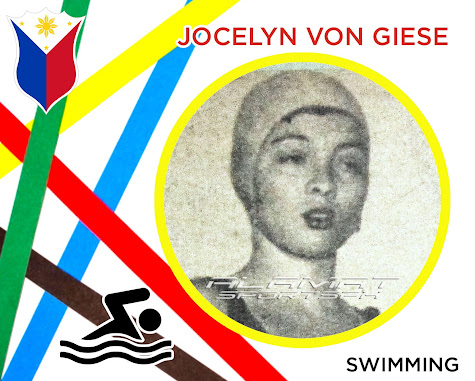Over half a century ago, four Filipina athletes distinguished themselves by becoming the first women from our country to compete in the quadrennial Olympics. It had taken them 32 years to get to Melbourne, the site of the 16th Olympiad.
In the 6 Olympics since 1924—when the first Filipino—sprinter David Nepomuceno, made his historic appearance in Paris, all the delegates sent to subsequent editions have been male athletes—swimmers, tracksters, shooters, weightlifters. The last Olympics before Melbourne had an all-male Philippine cast of 25 athletes. That changed when 4 nationally-ranked Filipina athletes were welcomed to join the games for the first time.
Let’s meet these pioneering Filipina athletes who were the first to flex their Pinay Power, long before the golden triumph of Hidylin Diaz in the game of all games that is the Olympics.
 |
FIRST FOUR. The first ever Filipina Olympians--Francisca Sanopal, Manolita Cinco,Getrudes Lozada and Jocelyn von Giese, march proudly into the Melbourne Olympic Stadium, with M. Shea, an official.
**********
FRANCISCA SANOPAL, Athletics (80m hurdles)
The Philippines’ top female low hurdler of the 1950s, Francisca Sanopal (b. 1931) was unbeatable in her specialty—the 80 meter hurdles. The national champion was sent to Melbourne to compete in her favorite event plus the century dash. But it was decided to scratch out of the 100 and concentrate on the hurdles where she had better chances. She ran in the qualifying Heat 5, clocking in at 11.8 secs. (hand-timed) or 12.15 (automatic time), good enough for 5th place. Francisca bettered her time in 1957, with an 11.4 clocking. In 1958, she made her presence felt at the Asian Games in Tokyo, winning two Silvers (80 m. hurdles, behind Japan’s Michiko Iwamoto in 4x 100 meter relay, with Inocencia Solis, Rogelia Ferrer, and Irene Penuela.
Manolita Cinco (born 1932), like Francisca, was a topnotch low hurdler at 80 meters, but she was also a champion sprinter. In Melbourne, she was supposed to compete in the 100 m. dash as well, but she scratched out, in favor of the low hurdles where teammate Francisca Sanopal was already entered. She ran in Heat 3, and registered a hand-time clocking of 12.1 seconds (12.20, automatic time), placing 7th and last. This experience served her well, as Manolita was won the Bronze two years later at the 1958 Asian Games in Tokyo, behind Francisca, who secured the Silver. A cancer survivor later in life, Manolita is married to Alejano Dopeno. Of the athletes of her generation, she says: “Disiplinado kami noon at masunurin sa coach. Walang incentives na pera pero serious kami lahat" (Back then, we were disciplined and we obeyed our coach. We didn’t receive any incentive, but we were all serious).
Gertrudes “Tuding” Lozada, born in 1943, came from the
famous swimming Lozada Family which originated swim schools in the country. Two
other sisters, Corazon and Tessie would become world-class swimmers like her.
But it was Tuding who was first to display her skill in the pool, winning races
early in various age meets in the country. Soon, she was beating adults at
sprints and middle-distance swimming races. Tuding surprised everyone when she
was named as member--and flag bearer-- of the Philippine swimming team for the 1956 Melbourne
Olympiad—she was just 13.
When the Philippine Team landed in Melbourne, Tuding became a media sensation. Newsmen covering the world’s premiere sporting event called the young teener, “Baby of the Olympics”. She was widely photographed and even athletes from other countries sought out the Filipina swimming prodigy to make her acquaintance. Tuding competed in two events—the 100 meter freestyle where she placed last in her heat, and in the 400 meter free, where she placed 6th.
Tuding would have a long career—winning Gold and Silver at the 1958 Asian Games (400 meter free, 4x100 m. freestyle); she was just 15. She would win more medals at the 1962 Asian Games (Silver, Bronze for 4x100 free, 4x100 individual medley). Tuding , the youngest Philippine Olympian in history (Akiko Thompson was almost 14 when she competed in her first Olympics in Seoul), retired from competitive swimming shortly in the 1970s, and today, she runs a swimming school bearing her name.
JOCELYN VON GIESE, Swimming (100m backstroke)
Jocelyn vin Giese (b. 1936) belongs to the sensational swimming von Giese sisters of the Philippines. Sisters Sonia, Sandra (b. 15 Nov. 1939), and Sylvia all made the national team that competed abroad, with the 2 elder girls making it to the Olympics. Of German-Filipino parentage, the four were nieces of famous actress Paraluman (Sigrid Von Giese, in real life) which was played up in media every time they competed.
SOURCES:
Manolita Cinco: http://manilastandard.net/mobile/article/151022
PROGRESS ’56, Sports in Post-War Philippines, p. 229, for photos of Manolita Cinco, Francisca Sanopal, von Giese
Photo of Gertrudes Lozada, Sunday Times Magazine, 1970.
www.sports-reference.com
(Bio,Stats, Results), for Francisca, Sanopal, Manolita Cinco, Gertrudes Lozada,
Jocelyn von Giese,









No comments:
Post a Comment